We had thought we’d stay in Santa Fe two nights, and then book it across Texas in order to get to New Orleans on Friday, where we have to turn the car in. But our hotel here, the lovely Las Palomas, does not have a vacancy tonight. We thought about just moving to another hotel for the night, but in checking through her books last night my lovely first wife discovered that one of the museums we wanted to visit (Site Santa Fe, an über-avant garde kind of place) is not even open on Tuesday.
Therefore, our plan now is to finish our stroll through downtown, make a few purchases, see the International Museum of Folk Art, and then book it across Texas. That will give us two days in New Orleans instead.
I’ll let you know how that goes.
—————
The first thing you notice about Santa Fe is that you can’t breathe. Denver may be the Mile-High City (for real), but Sante Fe is higher than that: 7000 feet above sea level. Just walking to your room leaves you gasping and nauseated. This is the highest we’ve been the entire trip.
The altitude sickness barely abates in 24 hours. Lots of water, and move slower. That’s about the only thing you can do.
Here we are at breakfast:
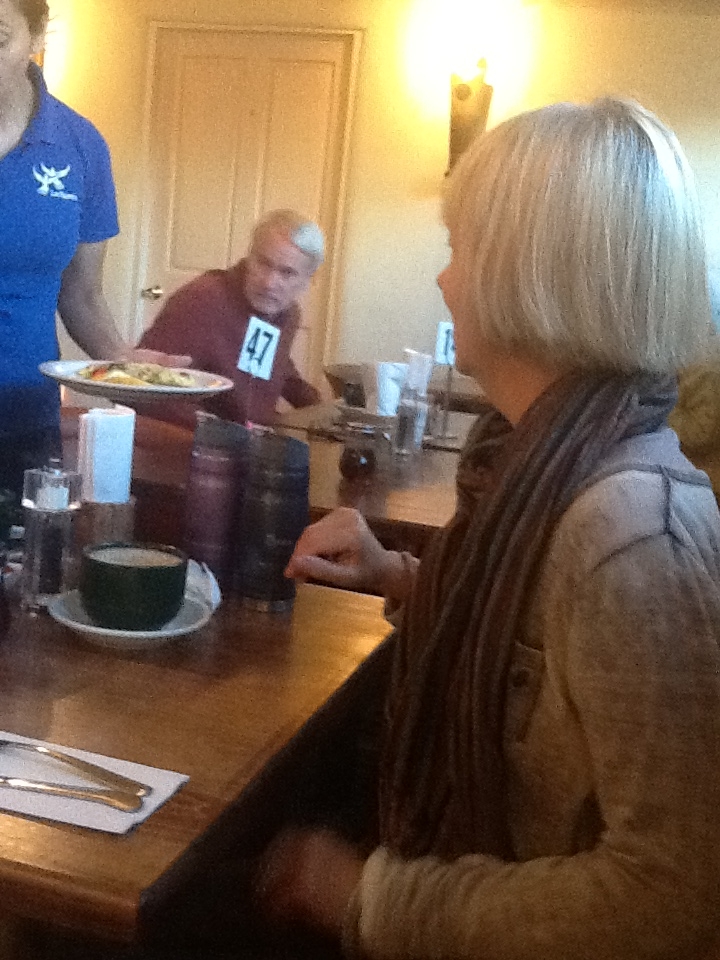
From there, we walked back to the Plaza and began our shopping. I splurged on two items: a new native flute (in D), and a flat shaman drum. Then we set to the serious business of the day—gifts. That kept us going all day. I am sorry I did not get a picture of the artisans under the arcade of the New Mexico History Museum. I thought yesterday they were the equivalent of those little roadside places that all sell the same crap, but boy was I wrong.
They are licensed Native American artists, and everything they sell they make themselves. That’s why when you pick up a lovely silver and turquoise necklace, it’s $1800 and not $49.99. Still, a lot of their stuff is affordable, and they will dicker. All their work is signed and most of it is very lovely.
In general, Santa Fe is an art lover’s mecca. Dozens of galleries downtown, and then a whole street, Canyon Street, of quirky and great stuff. We merely drove through Canyon Street; it’s on our list for when we return.
After our shopping spree downtown, we hopped in the car and drove up to Museum Hill, where we went to the Museum of International Folk Art.
Oh my.
Here’s the entrance. You must understand that this is one of several museums up here.
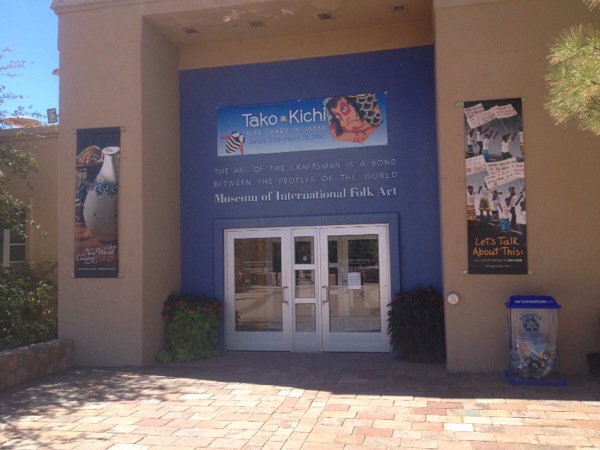
Here’s a bench outside:
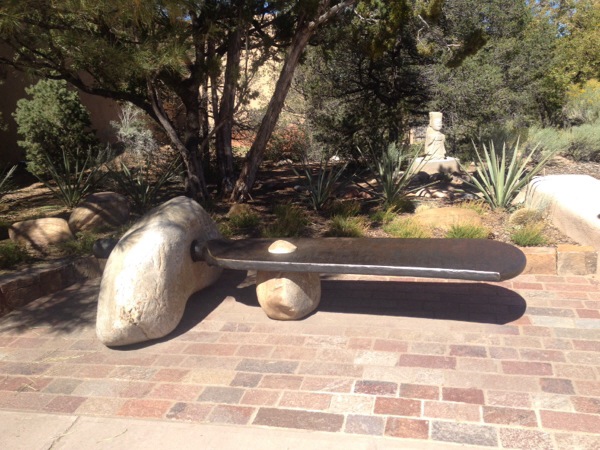
This is what Santa Fe is like, all over the city. A neoprimitive, deliberate design instead of a park bench? Sure, why not.
They have a labyrinth. It’s a variant of the 7-circuit pattern, i.e., mine, and it’s slightly domed.

Here’s the entrance:
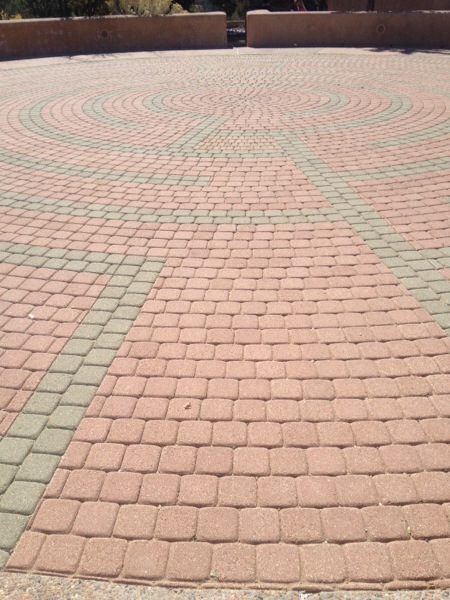
Here I am at the center:
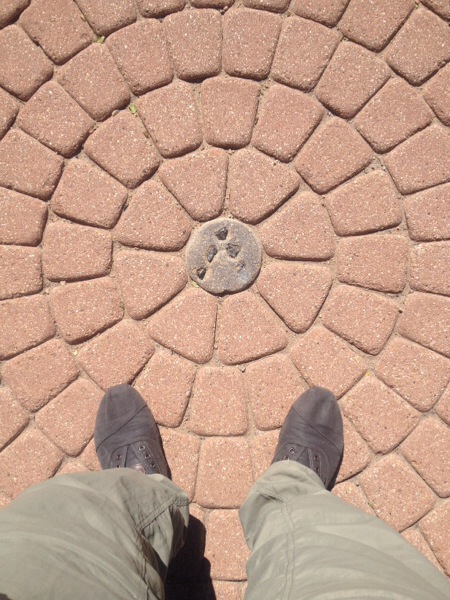
The little arrow points South. Don’t know why. That means you enter from the North. There are no markers for the cardinal points otherwise.
Here’s the view from the center:
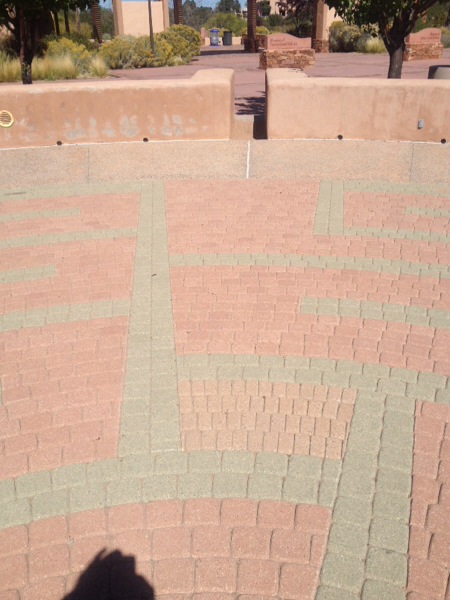
It was odd walking an unfamiliar pattern. I didn’t have time to even begin to figure out its metaphor, of course, but that’s okay. Sometimes a walk in the labyrinth is just a walk.
An interesting thing about this labyrinth: because of the dome shape and the wall, you get a spooky echo when you stand in the center and whisper. Your sibilants just come bouncing back to you like ghosts. One wonders if it were deliberate or just an accidental gift from the gods.
Inside, the bulk of the museum is taken up by the Girard Wing.

But, you will say, that looks like a Walmart, not a museum. You would be wrong. Alexander Girard and his wife collected folk art. This is not their collection. This is one-tenth of their collection. This is just an exhibit of that tenth.
It is absolutely overwhelming. Skip the Georgia O’Keefe Museum if you have to, but do not miss this museum. The mind boggles at the sheer volume of human artistic expression.
Pay attention. We have a lot to work through here.
The first idea you should take away from here is that anyone who says that art is a frill and students don’t need to be wasting time on it should be taken out back of the Capitol and shot. Publicly. (Maybe CNN could get better ratings that way if C-SPAN doesn’t beat them to it.)
It is clear from this collection that creating stuff, making stuff, is just part of us. We cannot help it. From the simplest materials, whatever is at hand, people will create objects which have meaning. Often that meaning is religious; over two-thirds of the items in the exhibit are specifically religious, mostly Christian but certainly not all. Sometimes the objects are for entertainment; a lot of puppets and dolls and scenes. Often the objects are functional, and sometimes the objects are just pretty.
Not all the objects are made by unsophisticated artists. There are a great many commercially produced items from the 18th and 19th centuries, dolls and doll house items, for example. Those did not hold my attention, however, as much as the hand-made-by-hand items.
I have a few random photos, snapped after I realized we were permitted to photograph the exhibit and I zipped back through trying to document the pieces that really stuck out. Not enough, alas. And they did not have a big heavy book covering the exhibit in the gift shop.
So let’s start here:
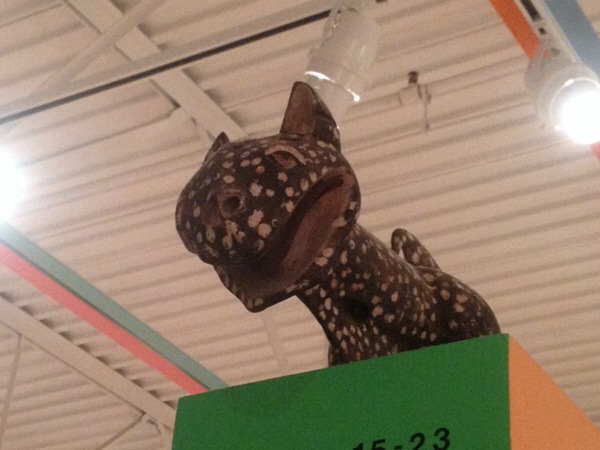
Jaguar, clay. Here is one of the facets of the exhibit. You’ll be walking along, fascinated by the cases and cases of objects, and then you’ll remember to look up, and there is entirely other exhibit going on over your head.
Whimsy:
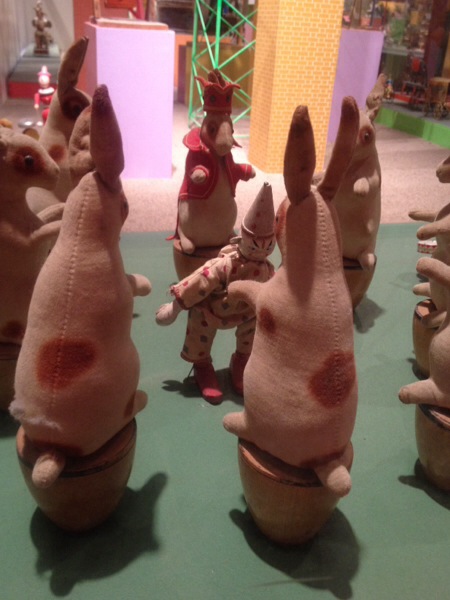
In the corner of an enormous circus display, we find this rabbit tamer. These scenes are mostly patched together from disparate items in the Girard’s collection—although there are a couple of gargantuan scenes with every item done by the same folk artist—and so whether the clown actually came with the rabbits is an open question. Nevertheless, it’s charming and more than a little bit creepy.
One thing that will strike you about the objects is how very very powerfully modern they are. Look at this:
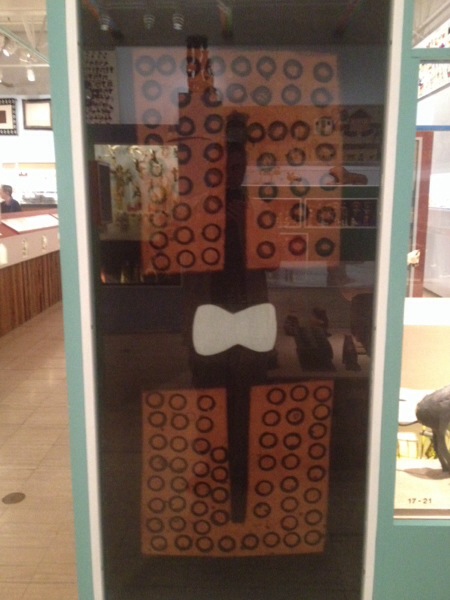
Terrible photo, but the reflections were unavoidable. If you saw this without any context, you would be forgiven for thinking you were looking at a painting from a gallery over at the Plaza, or over on Canyon Road. It is beyond sophisticated in its design.
But it’s a hunter’s jacket. The bow-tie-shaped white space is the hole for your head. Close up, in the upper lefthand corner, there is actually a pocket.
Close up, it’s even more sophisticated. The fabric is the brown; the black is dye. The rings look as if they’ve been double-stamped, with a slight registration problem, that is, dimmer gray circles can be seen just off kilter with the black.
Here’s another textile:
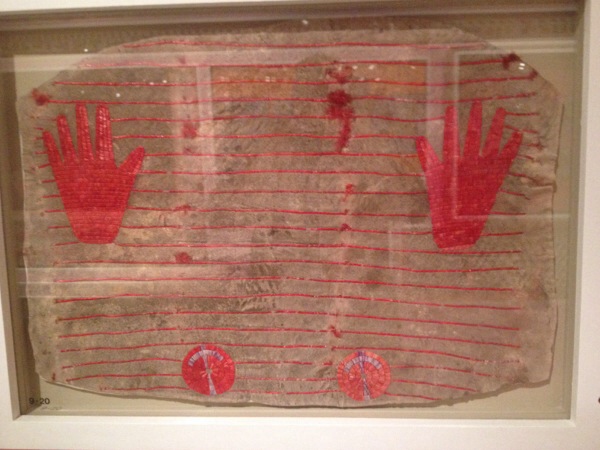
I cannot remember what this was, functionally. It’s embroidered. Seriously, people, artists have to go to SCAD to get this sophisticated in their approach to materials and design.
How about this:
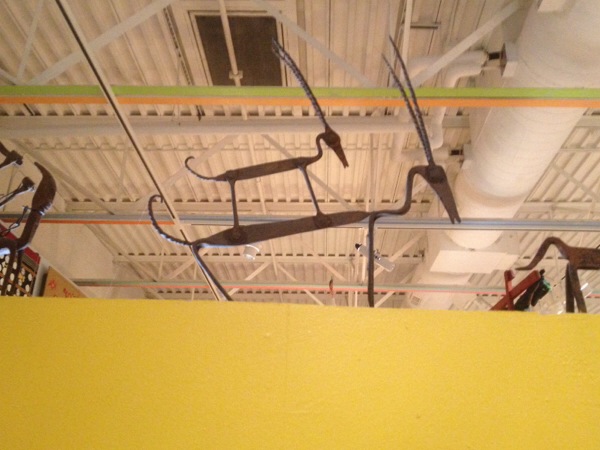
You’ll notice it’s part of a parade of iron pieces.
Another textile:
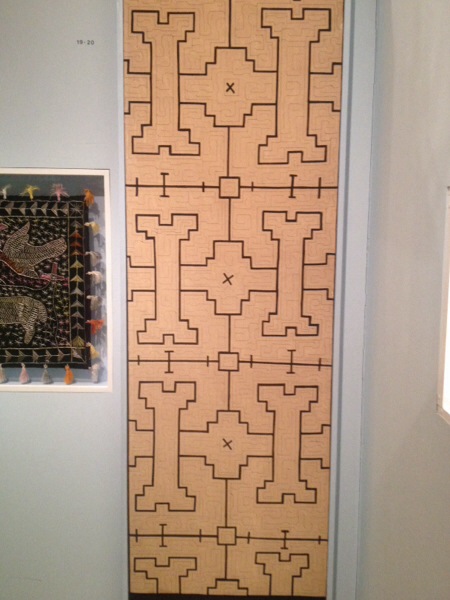
This one is from Peru. Look closely at it.
Now look at the closeup:
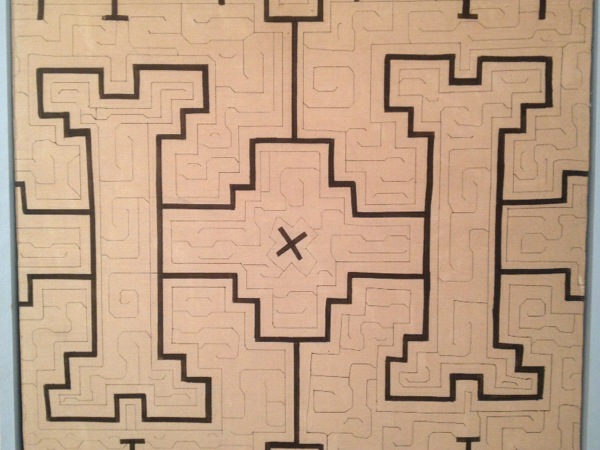
The whole thing is hand-stitched. Keep looking at it. Really, just keep looking at it.
…
Now remember that this is just one item out of an entire Walmart of items just like it.
The first idea we looked at was that humans are artists and it’s part of who we are. The second idea I came away with was that given sufficient materials and time, humans prefer the ornate, the baroque, the over-the-top.
This is a thing used in religious processions:
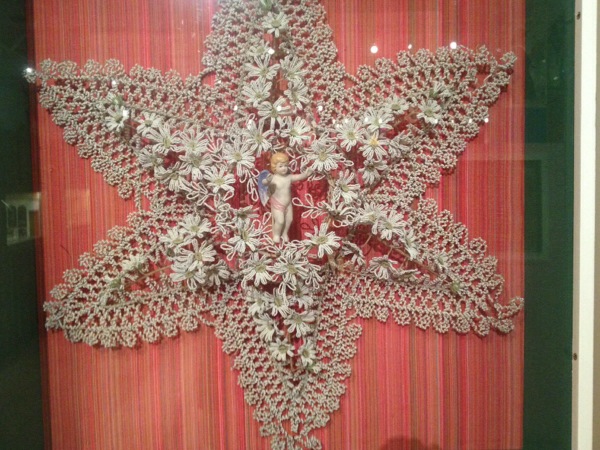
See what I mean? But wait, there’s more:
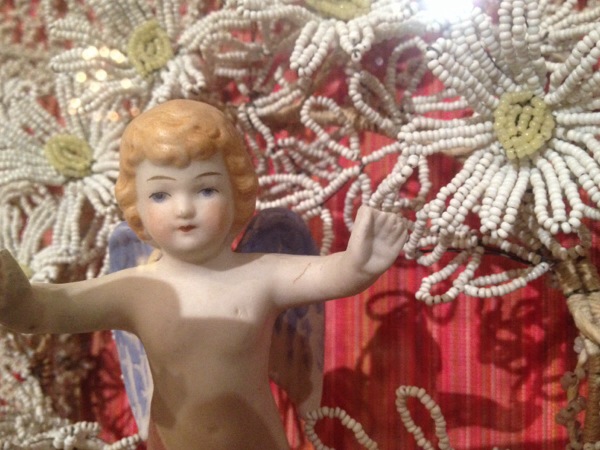
That’s right, all those wires are covered with beads. Thousands and thousands of beads. The exhibit was full of such items, and the idea that most of them are “objects of devotion” seems an insufficient explanation to our modern minds for the utter time-consuming work it took to create them.
This is from Poland:

It’s about four feet tall, made of wood, and covered with foil. All the little people (sold separately) are handcarved. Notice the floral arrangements to either side. Yes, all the flowers are handmade.
This tendency to the exuberant could be seen throughout the exhibit. If the objects were simple, there would be a lot of them. But often the objects were not simple.
Our third idea flows from the first: why aren’t we all folk artists? Why aren’t you? Unlike the idiots who stand in front of a Pollock or a Mondrian and say, “Herrgh, I could do that” (Protip: no you couldn’t), you can make art.
I confronted my lovely first wife with this proposition and she demurred. She doesn’t have artistic talent, she said.
Look at these masks, I said:

Are they polished? Are they “professional”? No. Do they have glaring “flaws”? Is it obvious that the humans who made them had no artistic training? Yes.
Are they beautiful?
Yes.
So why not you?
Look at this:
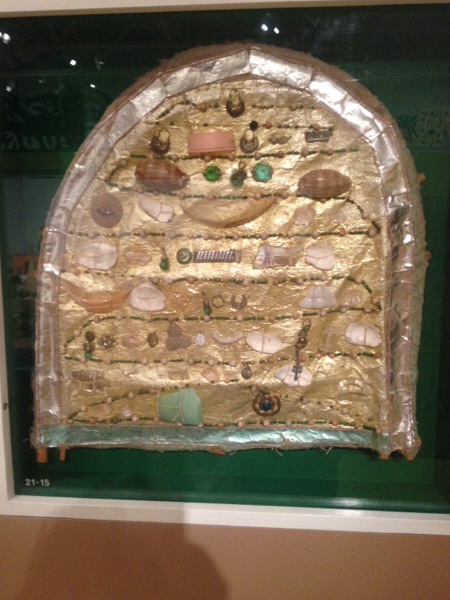
It’s part of a headdress for a Catholic festival procession.
Now look closely:
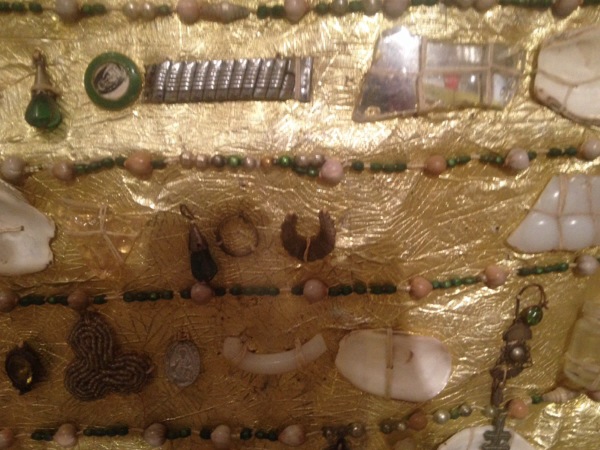
Do you see it? The maker of this has taken a piece of gold fabric and stitched trash, ladies and gentlemen, onto a religious article. (Not coincidentally, this flows from our idea #2.) The maker has taken whatever was to hand—broken glass, beads, charms, keys—and splashed it onto that pretty fabric in an almost random manner. It’s gorgeous in its simplicity/complexity.
What do you have lying around the house? Do you, on your morning walk, leave lying in the street the makings of a pretty thing?
Something more modern, perhaps?
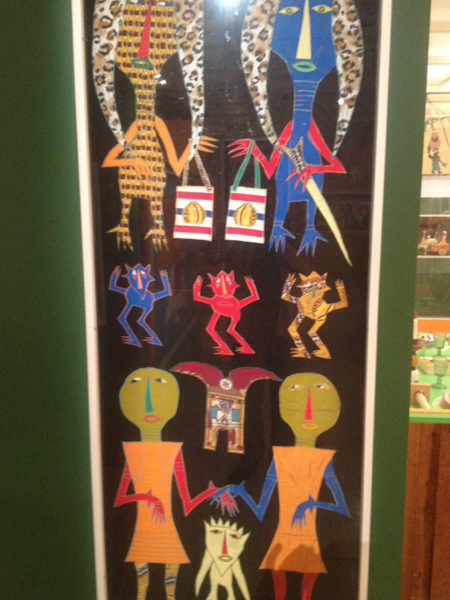
This is a machine-stitched tapestry from Africa.
Closeup:
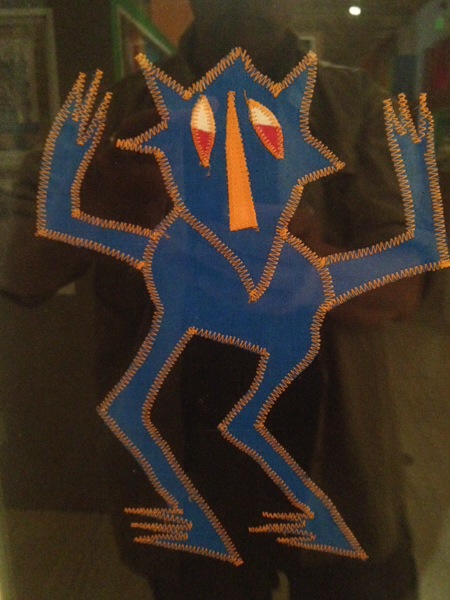
Got a sewing machine?
Got a Hobby Lobby?
A huge part of our reluctance to plunge in and make stuff is the fact that we are college-educated, middle class Westerners. We can’t make a thing like these things. It wouldn’t be “right.”
Wait, what? Why not?
We’d expose our “untalentedness” to others.
Really? If you made something as beautiful as any one of these things, you’d be the envy of others.
But as over-educated, middle class Westerners, shouldn’t we be expected to produce more polished, academic work?
Well, I suppose if you went to an academy…
Enough. Go make a thing.
—————
The Girard collection leaves you breathless (even for Santa Fe). It’s truly so overwhelming that it’s hard to make your brain get back to the real world. I had this problem after Grand Canyon and Monument Valley as well, finding it difficult to concentrate on driving even.
This was even more extreme, so it’s a good thing there were several more exhibits to get through. There was one on Southwestern cuisine as relates to chocolate (!) and yerba mate. Kitchens from different eras were displayed, with all the practical objects identified. Lovely chocolate sets and mate sets. We’ll be having some interesting cocoa in the next few months—they had recipe cards.
A powerful exhibit of worldwide folk artists’ responses to AIDS/HIV. The work of women artists was particularly interesting, since they had clearly decided that their societies’ traditional morality and modesty was getting them nowhere, and their voices were bracingly strident: put a condom on that thing, buster.
An exhibit of Japanese kites, like the Girard exhibit the collection of a single man. Hundreds of kites, grouped by region.
We exited through the gift shop, as usual. I was extremely disappointed that the only book they had on the Girard exhibit was nowhere close to being representative of the exhibit. Nor were there any replicas of my favorite pieces. Hello, people, let’s get to work here!
I did pick up a couple of items.

At the entrance to the exhibit, before you even get into the Walmart portion, there’s a whole wall of charms and amulets, showcased by country of origin. This is an amulet resembling those from Italy. Your guess is as good as mine as to what it might protect me from.
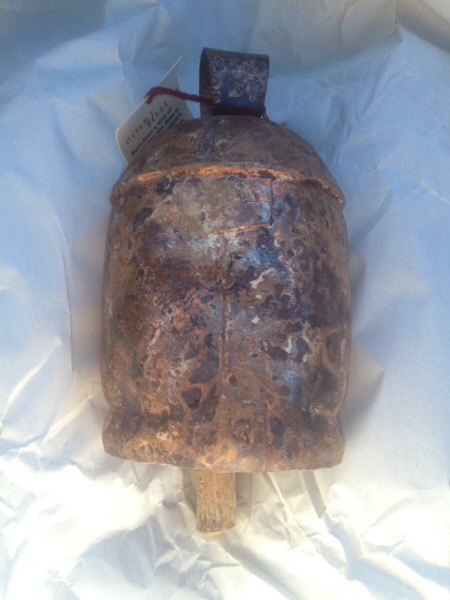
A bell from India. You might think it has a clunky, cowbell-like tone, but it chimes with a long reverb. Had to have it for the labyrinth.
I also got a book by Barbara Ehrenreich that I didn’t know she had written, Dancing in the Streets: a history of collective joy. It chronicles group ecstasy from its primitive roots through Dionysus and Jesus, then the Puritan stuff, all the way up to a chapter called “The Carnivalization of Sports.” Let’s dance!
—————
After the museum, we drove down Canyon Street, which is nothing but one fabulous art gallery after another. Bookmarked for a return trip.
I set our course for Amarillo, TX, and we were taken through unpaved residential streets to the nearest highway. Even on these unpaved streets, there were some really nice homes, all adobe and walled.
We have approximately 19 hours of driving to get to New Orleans by Thursday. Through Texas. Blogging may be a little less interesting for a while.
So uninteresting in fact, that when we finally saw multiple billboards for the Flying C Truck Stop WITH A DAIRY QUEEN YOU GUYS, we had to stop.

All kinds of marvelously tacky merchandise. You are all very lucky we didn’t win the lottery, because you’d all be receiving life-sized glazed ceramic coyotes.
Hit the road and eventually decided to give up whenever we got to Amarillo. Among the things we’ve learned on this trip is that there is not an exit coming up. There will not be a place to eat or to pee or to gas up. If you see a place, STOP.
Using the wonders of the intertubes, I found a hotel with laundry facilities—about which more in the next post—and we stopped for the evening. We had supper at the next door Outback. Told you blogging was going to be less interesting.